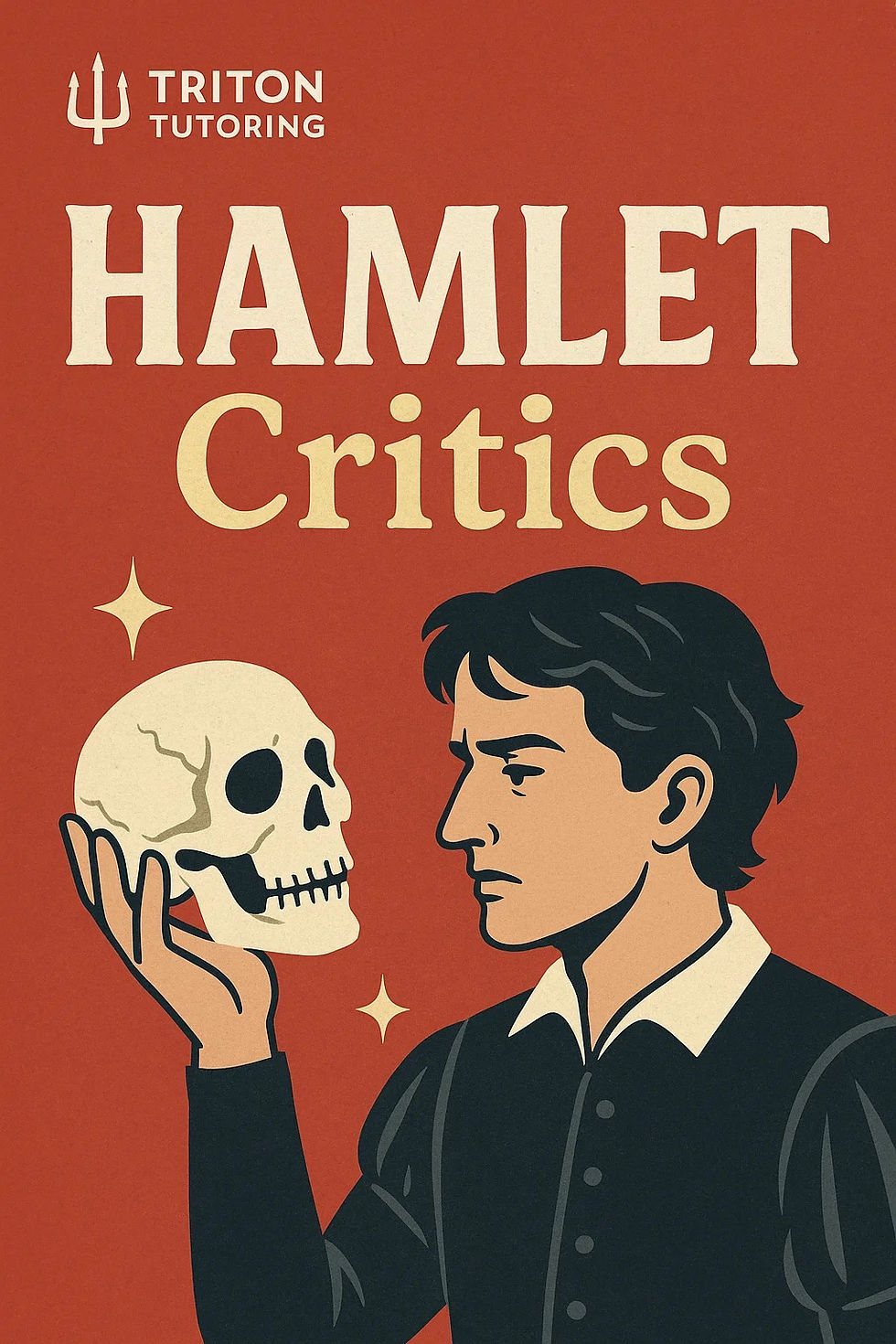🎭 Hamlet: Influential Critics & Their Key Observations
- Haydn Wood

- Jul 6
- 3 min read
Here is an expanded and detailed overview of major critical voices on Hamlet, offering fresh analytical angles to enrich your essays:
1. A. C. Bradley – The Tragic Hero’s Psychological Depth
Core Idea: Regards Hamlet as Shakespeare’s most complex tragic figure, whose melancholic temperament causes hesitation.
Insight: His delay in avenging his father stems not from cowardice, but from intense moral sensitivity and emotional introspection.
Application: Use Bradley to challenge simplistic readings—present Hamlet’s delay as profound inner conflict, not weak will.
2. Sigmund Freud & Ernest Jones – Psychoanalytic Dimensions
Core Idea: Hamlet’s inaction is driven by unconscious psychological motives.
Insight: Repressed desires toward his mother and an unconscious rivalry with Claudius block Hamlet’s ability to act decisively.
Application: Frame Hamlet’s hesitation as a psychological barrier, rooted in internal family tensions, not mere plot delay.
3. T. S. Eliot – Drama vs Poetry Tension
Core Idea: Argues Hamlet lacks clear emotional “objective correlatives”—dramatic actions that fully express inner turmoil.
Insight: Hamlet’s language conveys powerful feelings, but the action doesn’t match this intensity, resulting in perceived imbalance.
Application: Use Eliot to critique the play’s form—acknowledge the richness of language, but question whether it translates into equally strong dramatic resolution.
4. Harold Bloom – Character as Creative Genius
Core Idea: Views Hamlet as a unique creation defined by self-reflection and consciousness.
Insight: The character’s inner intellect and ongoing questioning of reality make him one of fiction’s most enigmatic figures.
Application: Emphasise the character’s innovativeness and self-awareness. Focus on moments of introspection and self-doubt to show Shakespeare’s artistic achievement.
5. Stephen Greenblatt – Renaissance Politics & Authority
Core Idea: The play reflects Elizabethan anxiety over monarchy, succession, and power.
Insight: Hamlet’s hesitancy parallels uncertainties about royal legitimacy and pressure on heirs in unstable times.
Application: Connect public anxiety about authority with Hamlet’s paranoia and doubts after his father’s suspicious death.
6. Marjorie Garber – Identity & Role-Playing
Core Idea: Focuses on theatricality and disguise—masks, roles, feigned madness.
Insight: Hamlet’s constant acting—whether as madman, actor, or dutiful son—suggests that identity itself is performative and fluid.
Application: Use Garber to explore how character and performance may blur inside the play, especially around Hamlet’s shifting mood.
7. Carol Rutter – Feminist & Gender Context
Core Idea: Critiques the depiction of female characters and power structures.
Insight: Ophelia and Gertrude reflect their limited roles, and their fates reveal the play’s patriarchal constraints.
Application: Frame Gertrude’s actions in the context of limited choice. Use Ophelia to examine how expression is punished in female characters.
8. John Kerrigan – Moral Uncertainty & Ambiguity
Core Idea: Focuses on the play’s constant moral tension—no clear moral centre, no tidy resolution.
Insight: Each act invites moral questions rather than answers, shifting responsibility and forcing audience reflection on justice.
Application: Use Kerrigan to discuss how scenes resist moral judgement—for instance, Hamlet’s struggle to weigh revenge with conscience.
9. Katherine Eisaman Maus – Renaissance Stage & Spectatorship
Core Idea: Examines the play’s engagement with audiences and theatrical conventions.
Insight: The use of play-within-a-play, direct audience address, dramatic irony—all foreground the act of watching and interpreting.
Application: Analyse how audience perception is shaped—e.g., do we trust Hamlet, or see him manipulating us?
10. Catherine Belsey – Postmodern Reading & Self-Referentiality
Core Idea: Approaches the play through a postmodern lens—highlighting how texts question their own storytelling.
Insight: Hamlet’s meta-theatrical elements, self-questioning and philosophical musings anticipate modernist concerns.
Application: Use Belsey to frame the play as an early exploration of subjectivity—where meaning is unstable and internal questioning undermines certainty.
🛠️ Using These Critics in Essays
Critical Voice | Focus Area | Essay Angle |
Bradley | Internal conflict | Character-driven psychological study |
Freud/Jones | Family repression | Subconscious emotional block |
Eliot | Dramatic structure | Tension between speech and action |
Bloom | Unique character artistry | Tragic character as literary innovation |
Greenblatt | Political resonance | Hamlet as mirror of power anxieties |
Garber | Performance & identity | Masks, roles, and self-presentation |
Rutter | Gender dynamics | Female voice under scrutiny |
Kerrigan | Ethical ambiguity | Moral questioning, not resolution |
Maus | Theatre and audience | How the play frames spectator roles |
Belsey | Meta-literary critique | Hamlet and uncertainty of meaning |
🧠 How to You Use These Critiques
Choose one perspective per essay—show depth, not scope-overload.
Quote Hamlet’s speeches or actions that fit your chosen lens.
Explain the critic’s key concept clearly and briefly.
Analyse the text through that lens, not just summarise the critic.
Show why it matters—connect your argument back to modern readers or ideas.


Comments